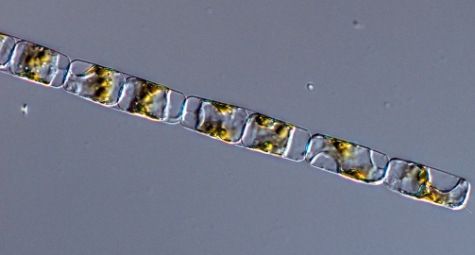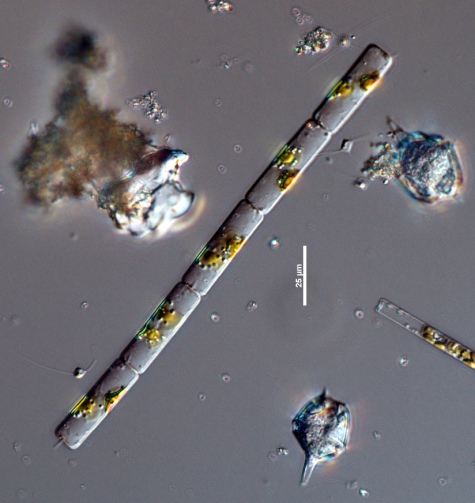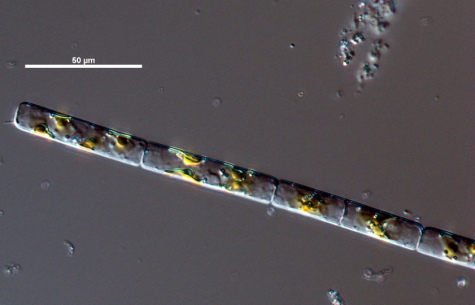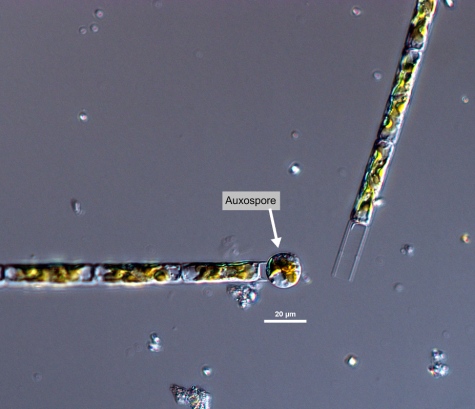




|
 |
Synonym(s)
Basionym
The original name for an organism. In botany, the original published nomenclature from which a new binomial nomenclature is derived for a particular group of organisms (Tindall 1999).
(basionym, CloseHomotypic
Expressing the same fundamental type or structure; may or may not be symmetrical (e.g., the two valves of a diatom, where they are the same shape and appearance, but one is bigger than the other). In naming species, a homotypic synonym is one that comes into being when a taxon gets a new name (without being added to an already existing taxon).
homotypic)(Guiry and Guiry 2011)
Classification
(Guiry 2011)
Lifestyle
Description
Valve
In diatoms, the structurally distinct halves of the cell wall (Becker 1996).
valves, rounded only slightly on the CloseMargin
The outline or border that defines the shape of an organism or cell.
margins. Cells are in close, straight chains. The valves have a short, slightly slanted, marginal spine that fits into a dent on the adjacent cell (Cupp 1943). Cells have large, irregularly lobed and strongly pigmented chloroplasts. Each chloroplast has a ClosePyrenoid
Any of various protein granules that can be found in the chloroplast of some algae species. It is associated with the production of starch.
pyrenoid (Kraberg et al. 2010). Cells are yellow-brown in colour (Guiry 2011).Intercalary bands
Girdle bands that are furthest away from the valve (Smithsonian 2011).
Intercalary bands are ring-shaped and difficult to see (Cupp 1943). "External depression with claspers " (EM; Sundstrom 1986, cited in Hasle and Syvertsen 1997).Measurements
Pervalvar axis
The axis through the centre point of the two valves of a frustule. This axis is perpendicular to the valve face.
(pervalvar axis): 20 - 70 μm (3 - 5 times the diameter)Diameter: 8 - 40 μm
(Kraberg et al. 2010)
Similar species
Harmful effects
Sedimentation
(settling out) The tendency for particles to settle out of the water column and come to rest at the bottom due to gravitational forces. Factors that influence the rate of sedimentation are particle size, water density and currents.
sedimentation, can inhibit growth of benthic shellfish by clogging the gills (Chauvaud et al. 1998, Lorrain et al. 2000). May be a source of arsenic (III) and methylated arsenic, which may block important biochemical pathways in algae, as arsenic is chemically similar to nitrogen and phosphorous (Howard et al. 1995).Habitat
Distribution
Warm to temperate regions (Hasle and Syvertsen 1997).
Blooms in late spring or summer (Gayoso 1999). Most abundant in summer in Northern European seas (Kraberg et al. 2010).
"Fairly common off California, abundant at times in the Gulf of California" (Cupp 1943).
Growth conditions
Freshet
A great rise or overflow of a river from heavy rains or spring thaw. In the Strait of Georgia, this usually occurs from March to June. (pers. comm. D. Cassis).
freshets in the fall (Malej 1995).Environmental Ranges
Temperature range (°C): -1.838 - 29.468
Nitrate (μmol L-1): 0.056 - 34.037
Salinity: 27.525 - 39.226
Oxygen (mL L-1): 1.767 - 8.586
Phosphate (μmol L-1): 0.046 - 2.358
Close
Silicic acid
A general term to describe chemical compounds containing silicon, oxygen and hydrogen with a general formula of [SiOx(OH)4-2x]n. Diatoms polymerize silicic acid into biogenic silica to form their frustules (Azam and Chisholm 1976).
Silicate (μmol L-1): 0.648 - 92.735(OBIS 2011, cited in EOL 2011)
Bloom characteristics
Unialgal
Related to a single phytoplankton cell. For example, a unialgal culture is one derived from a single cell.
Unialgal blooms of this species are known to follow the spring species succession (Grail and Jacques 1964, Grail 1972, Martin-Jézéquel 1983, all cited in Martin-Jézéquel et al. 1992).References
Cupp, E. E. 1943. Marine Plankton Diatoms of the West Coast of North America. University of California Press. Berkeley, California. 238.
Chauvaud, L., Thouzeau, G. and Paulet, Y. M. 1998. Effects of environmental factors on the daily growth rate. Journal of Experimental Marine Biology and Ecology. 227: 83.
Encyclopedia of Life (EOL). Guinardia delicatula (Cleve) G. R. Hasle. http://www.eol.org/pages/907116. Accessed 16 Jul 2011.
Gayoso, A. M. 1999. Seasonal Succession Patterns of Phytoplankton in the Bahía Blanca Estuary (Argentina). Botanica Marina. 42: 367-375.
Grall, J. R. 1972. Developpement 'printanier'; de la diatomde Rhizosolenia delicatula pres de Roscoff. Mar. Biol. 16: 41-48.
Grall, J. R. and Jacques, G. 1964. Etude dynamique et variations saisonnieres du plancton de la region de Roscoff. Cahiers de Biologie Marine. 5: 423-455.
Guiry, M. D. 2011. Guinardia delicatula (Cleve) Hasle, 1997. http://www.marinespecies.org/aphia.php?p=taxdetails&id=149112. Accessed 16 Jul 2011.
Guiry, M. D., Guiry, G. M. 2011. Guinardia delicatula (Cleve) Hasle. http://www.algaebase.org/search/species/detail/?species_id=43911. Accessed 16 Jul 2011.
Hasle, G. R. and Syvertsen, E. E. 1997. Marine diatoms. In: Tomas, C. R. (ed.) Identifying Marine Phytoplankton. Academic Press, Inc., San Diego. 5-385.
Howard, A. G., Comber, S. D. W., Kifle, D., Antai, E. E. and Purdie, D. A. 1995. Arsenic speciation and seasonal changes in nutrient availability and micro-plankton abundance in Southampton Water, U.K. Estuarine, Coastal and Shelf Science. 40(4): 435-450.
Kraberg, A., Baumann, M. and Durselen, C. D. 2010. Coastal Phytoplankton: Photo Guide for Northern European Seas. Verlag Dr. Friedrich Pfeil, Munchen, Germany. 204.
Lorrain, A., Paulet, Y. M., Chauvaud, L., Savoye, N., Nezan, E. and Guerin, L. 2000. Growth anomalies in Pecten maximus from coastal waters (Bay of Brest, France): relationship with diatom blooms. Journal of Marine Biological Association of the United Kingdom. 80(4): 667-673.
Malej, A., Mozetic, P., Malacic, V., Terzic, S. and Ahel, M. 1995. Phytoplankton responses to freshwater inputs in a small semi-enclosed gulf (Gulf of Trieste, Adriatic Sea). Marine Ecology Progress Series. 120(1-3): 111-121.
Martin-Jézéquel, V. 1983. Facteurs hydrologiques et phytoplancton en Baie de Morlaix (Manche Occidentale). Hydrobiologia. 102: 131-143.
Martin-Jézéquel, V., Sournia, A. and Birrien, J. L. 1992. A daily study of the diatom spring bloom at Roscoff (France) in 1985. III. Free amino acids composition studied by HPLC analysis. Journal of Plankton Research. 14(3): 409-421.
Ocean Biogeographic Information System (OBIS). Guinardia delicatula. http://www.iobis.org/mapper/?taxon_id=449116. Accessed 16 Jul 2011.
Sundstrom, B. G. 1986. The marine diatom genus Rhizosolenia. Doctoral Dissertation. Lund University, Lund, Sweden. 117.
